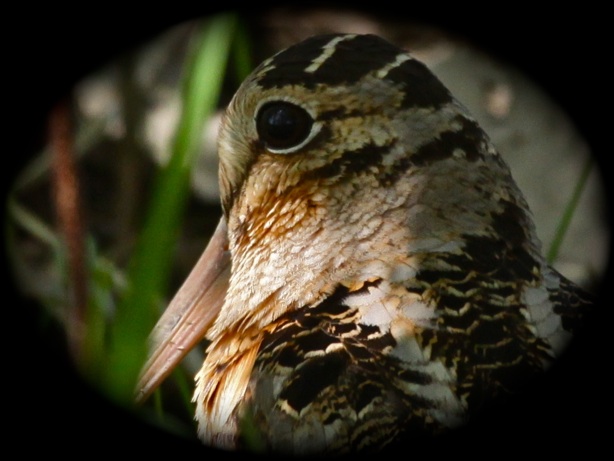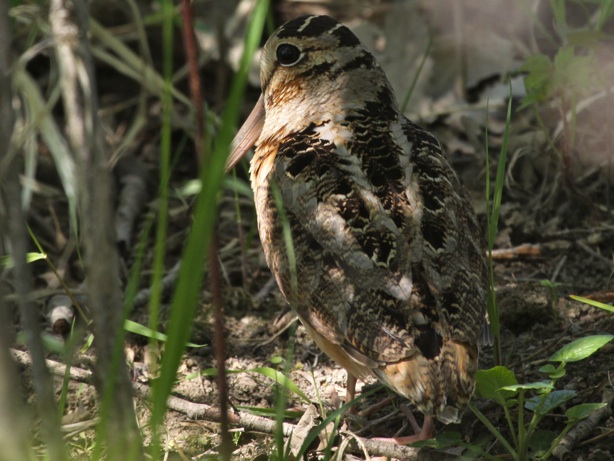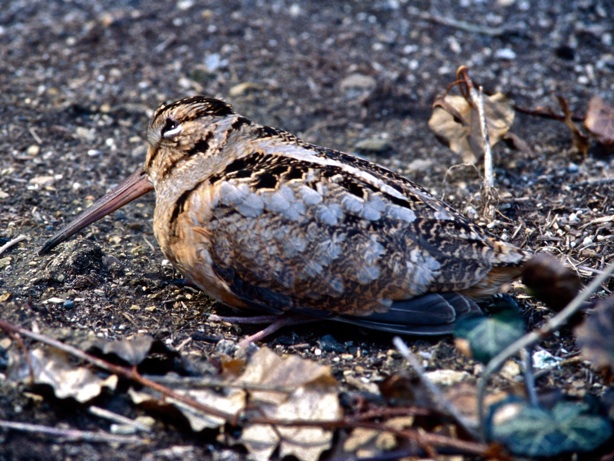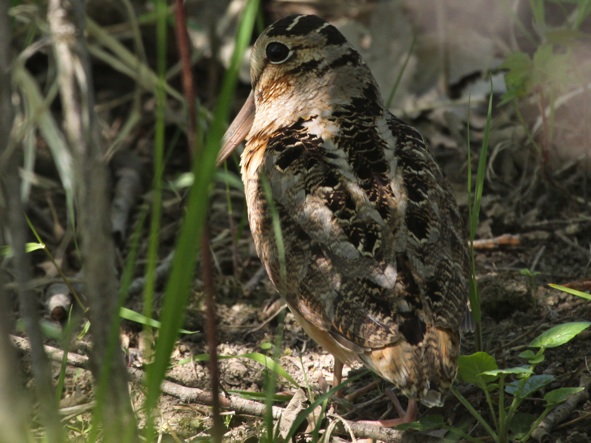The Nature
Observer’s Journal
The Nature
Observer’s Journal

March Madness
the woodcock’s sky dance
Chuck Tague
Timberdoodle sounds silly but it’s a fitting nickname for the American Woodcock. The woodcock is, undeniably, a ridiculous bird. Although it’s in the sandpiper family, don’t look for a one at the beach. Timberdoodles live in the woods and strut around the forest floor with a comical, off-balance stride. They can’t help it. They carry an extremely long beak on very short legs. The pattern and color of their feathers perfectly match the leaf litter. You won’t see one, even if it’s only a few feet in front of you. It won’t move, either, until you’re about to step on it. Then, it doesn’t fly, it blasts off and leaves you still as a statue, waiting for your heart to restart.
Timberdoodles occupy the dimly lit forest floor and are most comfortable in the twilights. Consequently their eyes are huge and bulge from the tops of their heads so they can spot approaching predators from any directions. Their eyes are so large and offset that the position of the eyes and brains are reversed.

Woodcock feed on small animals. It uses vision to locate snails and spiders on the surface, but it locates most of its food underground with its sense of touch. A timberdoodle can poke its entire beak into the soil to extract earthworms. The tip of its beak is not only loaded with sensitive nerve endings, the upper beak is prehensile. It can curl the tip around a nightcrawler and pluck it out. As it hunts for worms a woodcock struts slowly. With each step it shifts its weight to the lead foot. It rocks its body up and down in a curious dance but keeps its head perfectly still. Supposedly this motion sends vibrations through the weighted foot into the ground and causes earthworms to move. The woodcock hears the movement and pokes at the worm. As the timberdoodle moves forward it uses its long beak like a walking stick to move vegetation from its path.
If there’s anything in the spring as comical as the timberdoodle’s appearance it’s their courtship display. These bizarre birds winter in the southern states and return to Pennsylvania in late February or early March, when the ground thaws enough to probe for worms. They are both the first ground nesting and the first migratory bird to breed. The males establish a singing ground in dense scrubby fields with scattered patches of open ground. Shortly after sundown, about the time humans lose their ability to perceive color, timberdoodle courtship begins. Each male starts by “peenting.” He repeatedly broadcasts a high-pitched, nasal “pZzzzz-dt.” Turning, strutting in a tight circle, he calls in all directions . . . “pZzzzz-dt,” . . . “pZzzzz-dt,” . . . “pZzzzz-dt.” The birds are so intent they won’t notice curious humans on the edge of their field. It’s best to watch from the eastern edge, facing the glow of the western horizon. You won’t be the only observers. Admiring female woodcock will also be nearby.

When the timberdoodle is sure that the field has been properly peented, and all the girls are watching, he explodes into flight. He takes off on a low trajectory that barely clears the brush, often in the direction of a rival displaying male. The three narrow and rigid outer primaries on his blurry wings produce a loud “whirr” as he blasts past your ear. His flight rises in an expanding spiral that takes him up three hundred feet or more. At the peak he begins to “chip” and descends to earth. Down he flutters in gentle arcs, each arc punctuated with a twittering “chip - chip - chip.” As he nears the ground the timberdoodle silently and lightly floats close to where he began, then drops like a helicopter. After a tasteful pause, he begins peenting again.
While the woodcock is airborne curious humans can move in and sit in the display ground. With some adjustments after a flight or two, the bird will almost land in your lap. Woodcock are too busy to care, unless you laugh out loud. Restraining your joy is not easy. When you get within three or four feet, you can hear the timberdoodle’s introductory call, a deep, sharp “tuko” between each “pZzzzz-dt.”
Male woodcock repeat this performance until the dim twilight gives way to darkness. After I leave, I laugh for hours.

Although woodcock are particular about their breeding habitat, during migration they often show up in unexpected places. When I lived in Pittsburgh’s South Hills, I twice found a woodcock sitting on a terraced ledge behind my garage, an excellent place for earthworms. When Joan worked downtown she found one along Stanwix Street, peacefully resting in a raised garden by the sidewalk, eye-level with lunchtime pedestrians who never noticed it.
After mating male woodcock have nothing to do with the female or young. The hen fashions a scrape on the ground in the woods. The only nest material is a few dead leaves. She lays four buff-colored eggs camouflaged with spots and blotches. As she incubates she sits tight, even as a human intruder approaches. Like other shorebirds the chicks are precocial (feathered, sighted and capable of following the hen away from the nest shortly after they hatch). Unlike most precocial chicks, newly hatched woodcock cannot feed themselves. They depend on the mother for the first week.
Males continue their courtship display long after the females are on the nest. Some males perform the sky dance well into May, although their performance loses vigor as the season winds down. It’s best to get out early. Enjoy the March madness.
You can watch an excellent video of a displaying woodcock by Lang Elliot (The Music of Nature) on You Tube: http://www.youtube.com/watch?v=4Owj52XhoxI&feature=related --

Tuesday, February 28, 2012
